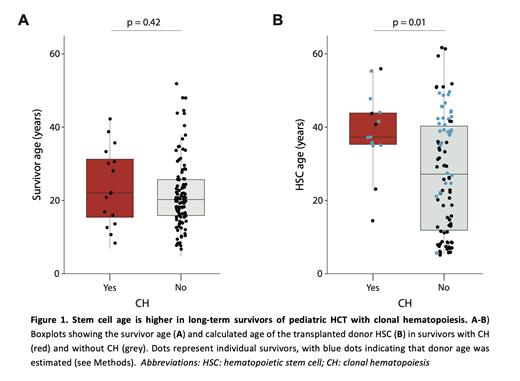Background
1. Approximately 20.000 to 200.000 hematopoietic stem and progenitor cells (HSPCs) contribute to steady-state adult hematopoiesis. During ageing, the overall diversity of the HSPC pool decreases, which is in part driven by the selective expansion of HSPC clones with driver mutations, a process called clonal hematopoiesis (CH). CH is an age-related condition that predisposes to hematologic malignancy, cardiovascular disease, and all-cause mortality. Hematopoietic stem cell transplantation (HCT) recipients are at increased risk of CH, but the mechanisms driving the emergence and expansion of CH clones are largely unknown. Furthermore, the prevalence of CH in pediatric HCT recipients, in whom the long-term consequences of CH are particularly relevant, remains to be defined.
Aim
To determine the prevalence and risk factors of CH in long-term survivors of HCT at pediatric age.
Methods
We included survivors of HCT at pediatric age, with a minimum survival of 5 years after HCT. CH was assessed by targeted, error-corrected sequencing of mutations in 27 cancer driver genes in whole blood, at a variant allele frequency detection threshold of 1%. HSC age was calculated by the sum of the age of the donor and the interval after HCT. In case the age of a donor was unknown (n=53), the median age for donors of the same donor relation were used (i.e., 12.6 years for sibling donors and 28.7 for matched unrelated donors). Clinical characteristics were compared using the Wilcoxon signed ranked test for continuous variables and Chi-squared or Fisher's exact test for categorical variables.
Results
Here, we report the interim results of the first 120 HCT survivors in this study. The median age of the survivors was 20.4 years (range 6.7-51.8), and the median interval after HCT was 11.8 years (range 5.2-38.2). Indications for HCT were hemato-oncology (n=95), bone marrow failure (n=22), or immune deficiency (n=3). The median calculated age of the HSCs was 31 years (range 5.2-61.8). CH was present in 13.3% of survivors (n=16). Mutated genes were DNMT3A (n=15), TET2 (n=4) and MPL (n=1), with three individuals having more than one driver mutation. The median variant allele frequency of the CH clones was 2.2%, but allele frequencies up to 30% were found. No differences were observed in recipient age or interval after HCT between individuals with or without CH (Figure 1A). However, the age of the HSCs was significantly higher in individuals with CH compared to those without (38.6 versus 26.3 years, p = 0.01, Figure 1B). Surprisingly, we detected CH in two recipients of umbilical cord blood grafts, at an interval of 11 and 15 years after HCT.
Conclusion
Clonal hematopoiesis is common in long-term survivors of pediatric HCT. After HCT, the prevalence of CH is related to the age of the transplanted HSCs, rather than the age of the survivor. The presence of CH in cord blood HSCs within two decades after HCT suggests that HCT-related factors may drive the de novo emergence and/or outgrowth of donor-derived CH. Ongoing research is aimed at investigating how factors such as stem cell source and post-transplant complications affect clonal expansion after HCT. Furthermore, we are investigating the prevalence of CH in an age-matched control cohort using the same detection pipeline, enabling direct comparison of the prevalence of CH in HCT survivors compared to the general population.
Disclosures
Nierkens:Sobi: Membership on an entity's Board of Directors or advisory committees. Lindemans:ExCellThera: Other: Data and safety monitoring board; Orchard Therapeutics: Membership on an entity's Board of Directors or advisory committees; Sobi: Membership on an entity's Board of Directors or advisory committees; Pfizer: Patents & Royalties: IL-22 in GvHD.


This feature is available to Subscribers Only
Sign In or Create an Account Close Modal